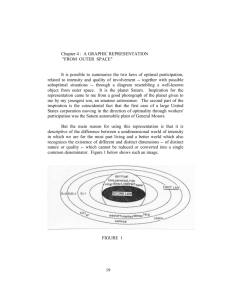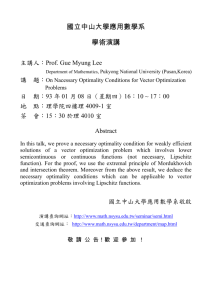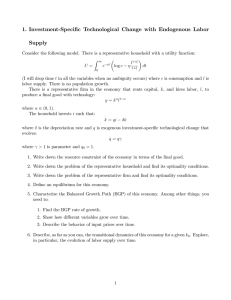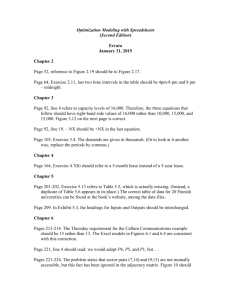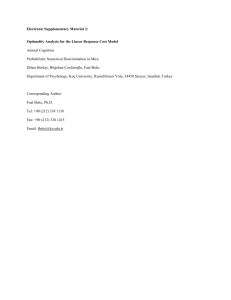ROBUST FILTERING OF IMAGES
advertisement
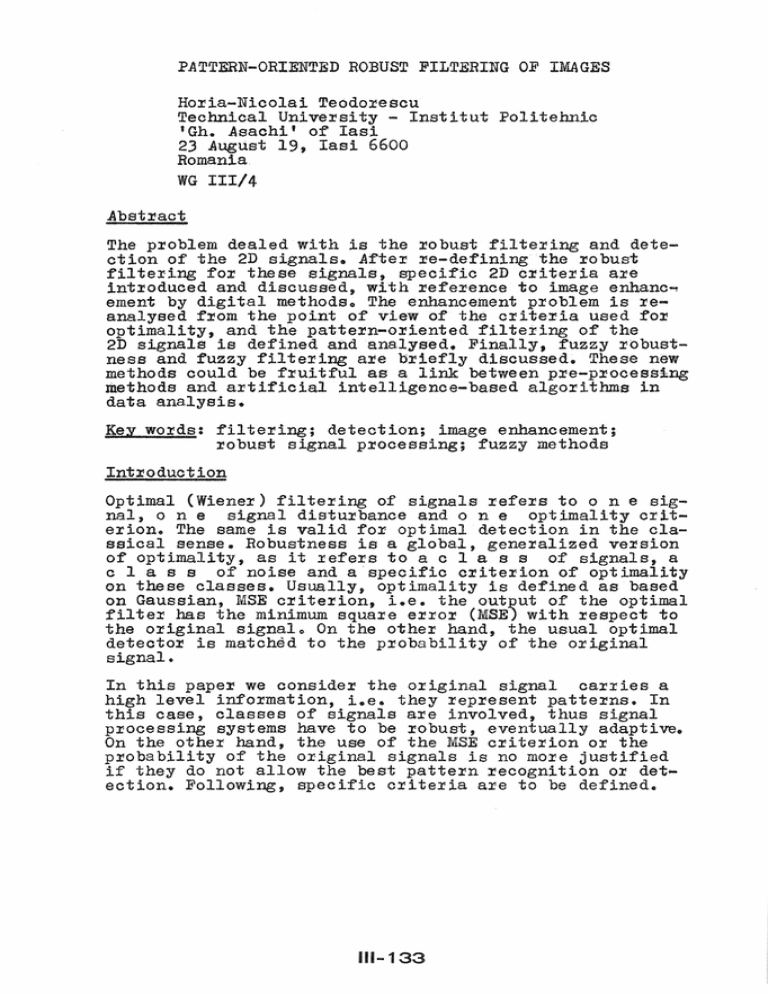
PATTERN-ORIENTED ROBUST FILTERING OF IMAGES HOlia-Nicolai Teodo~escu Technical University - Institut Politehnic 'Gh. Asaohi' of Iasl 23 August 19, Iasi 6600 Romania \VG I1I/4 Abstract The problem dealed with is the robust filtering and detection of the 2D signals. After re-defining the :robust filte~ing for these signals, specific 2D critexia are introduced and discussed, with reference to image anhanc..., amant by digital methodso The enhanoement problem is reanalysed from the point of view of the criteria used for optima,lity, and the patte1'n-oriented filtering of the 2D signals is defined andana,lysed. Finally, fuzzy :robustness and fuzzy filtering Sl!e briefly discussed. These new methods could be fruitful as a link between pre-p=ttooess1ng methods and artificial intelligence-based algorithms in data ana,lysie. Key wOl'da: filtering; detection; image enhancement; robust signal pl'ocessing; fuzzy methods Int~oduction Optimal (Wiener) filtexing of signa.ls refexB to 0 n e signal, 0 n e signal disturbance and 0 n e optimality oriterion. The sa,rne is valid fol' optimal detection in the ola.... ssical sense. Robustness is a global, gene:rallzed vel'sion of optimality, as it :refers to a c l a s s of signals, a c 1 a. s s of noise and a 'specific critexlon of optimality on these classes. Usua,lly, optimality is defined as based on Gaussian, MSE critexion, i.e. the out~ut of the optimal filte!' has the minimum squaxe e1'to1' (MSE) with respect to the o1'iginal signell) On the othex hand, the usual optimal detector is matched to the probability of the oJ:iginal signal. In this pa.per we consider the original signal carr:ies a high level informa.tion, i.e. they :represent patte=rns. In this case, classes of signals are involved, thus signal p:rocessing systems have to be robust, eventually adaptive. On the othex hand, the use of the MSE criterion or the p1'obability of the o:riginal signals is no mo:re justified if they do not a.llow the best patteJ:ln recognition OJ:l detection. Following, specific oritexia are to be defined. 111 ... 133 In this paragraph we define the pattern-oriented filter (pot') and contrast it with the usual one. Note §( the o:riginal signal, F( s) the tranefe:r function of the fil te:r, 8 = F(e), whaxe s the input (noisy) signal. Conside:r the t'iltel'ed Signals axe to be used fOl: pattern :recognition, the :recognition process consisting in a ma.pping r: S -- P whe:re S is the of Signals and P the class of patt .... exne (usually a discrete class ). Consider a norm 17 II defined on the space of pattel!ns. Than, the nstlUs1 optimality criterion is: (1) minFII r(:F\(s}) - r (~)I/ := minl/r:(§)-r(fJ)/1 Contrast (1) to the usual optimality critexion: (2) minFI F(a) - ~I = min /~ - ~I where I I xep:resent s the norm on the space of signals, eventually defined in the Gaussian manne:!!. Note that (2) does :not genel'slly implies (1), ioe .. the crresponding optimal filters differ. In many pl:actical oases, signals represent patterns (at least the oxiginalsignals). Thus the use of' a pattern-oriented criterion as defined by (l~ is largely justified. Pattern-ol'.iented :robust filtexing noisy If the problem of filtering involves a class denoted vel the same sisnal " the class be by S, than orite (1) can lead to various robustness criteria, e.g.: (3) minF S r(~) - r(~)11 or: minF maxS II r(~) - r(~)/I Conditions (3) and (4) are straightforward extended to (4) e the case of a class of original signals oorrupted by a class of noise aignalst by repla.cing in (3) and (4) the class S by the class Z of all ol:iginal signals as corrupted by all possible noise signals. Note that (3) requires a global opt , while (4) implies the minimization of recognition error the worst case. It is obvious that in general, the po robust filte:r and theueual (MSE) :robust filtex a1'e diffexent, for the same :reasons the po optima.l and the optimal filtel's aI'e diffexent q Comparison of the po optima.l- and optimal filters The following remarks help in contrasting the two types of til te:ra B,nd in choosing the usual optimal fil tel's for recognition purposes .. 111-1 Bemax-k 1. If I~ 11~(8) - e/, - l(~)11 is a monotonous funotion in than the po fil tex and the optilua1 fil- tex (2) are the same. Remark 2. If J:(~) == x-(~) for any ~ sote Is - 'il ia less tha.n q and if the optimal filtex yields a.n err<Dl:' less than q, it the optimal filtexo Note J.. In Rema:rk 1, the no:r:m / I I I can be inteJ:px-eted as a, measuxe of :recOgnition, e.g. the probability of recognit- ion. The function involved, in va:r1able 18-~/t must in this case be an increasing one. On the othe:r ha.nd, the domain of monotony can be xest:r1cted as follows. Let q be the value of the signal such as the function discussed has a, minimum in q, and q is the value which the ~-CloE:r with this property. Let be u the value the tU.notion corresponding to q and v the 'i-OloseJ: value of ~ such as the value of the function in v be u o If the function is monotonous in the intexval O••• v, and if the optimal filtex error is less tha,n IV-fi/, than it is po-optimal o Otherwise, there is a filter which is po-optimal and which differs f~om the (usual) optimal filter. Note 20 If II 1/ is a function of I//~ - ~/I/, wher-e III III is a nOl'm different than / I, in genal'sl the pooptimal filter and the optimal filte! are diffel'ent. Above, it was considered the CBse of a single pattern, i.a Ct one pa.ttern and the t chaos t , or: ftthis .A (the pattern), or it is not" oaseo Note that this problem is equivalent to the deteotion one. Of course, the above lemal'ks can be extended with more than a. patte:rn. AnalYsis of optimality for 2D signals processing It is worth mentioning that in common inferenoe,"image n means a collection of patterns. Without any pattern, a 2D signal is not an image, but merely a luminanoe PJ:ocess~ requiel'ing no filtering or detection. Thus, in what follows we restrict the discussion only to true imageso Probably the most important pa.;rametex an image its resolution, i.eo its capability to carll denae 1nformat1o~ It is known that this px-opexty is directly conneoted to the oontouJ:s of the domains in the image, that is to the higher frequenoy band in the spectrum. FollOwing, the information content caxxied by various fx-equenoy bands in a imageeignal is not the same, as usually happens fOl! ID signalso Thus, the optimal filters for 2D signals must preserve the :Lnformationin these HF bands in the flJ:st place. At least. some weights for valious frequenoy banda must be used to a,ccuratelly describe the optimality in 2D signals processing. We consider two ways to include in the optimality and :robustness criteria the specifioity requi~ed by image signa~. The fixst is to weight the signals in eq.(2) by a weight- 111 . . 1 ing function co~responding to a high pass or band pass til tar.. The second way is to use the po processill..g of g~$~~~~.' as described by eq. (1). Of course_ the fi~st way is just a fi~st step towaxds po-filtering. has however the advantage of using well established methods, already available. Fu~theron, robust 1s an extension of classes of signals by eqs. (3) and (4). p~ooessing of images desc~ibed optimal methods to the above and noise, as deso~ibed Fuzzl oRtimal and robust processing of images The:re are many cases when the classes sig:na.ls and noise, and possibly the systems used in signal processing can not be desczihed in a, crisp or probabilist manner. Fo: examplet this can happens when only a partial statistic is availableo In such circumstances, is suitable to consider the classes as fuzzy set s, and the signaler to be consldel'ed as belonging to these classes as by a membership function. Then, one ca.n introduce specific optimality and robustness cxitex ,based on the membership functions, as in /1/, eventually so using fuzzy inference * In this case, there is more than one possible criterion. Instead of that presented /1/, one can use fol' example: (5 ) miDta maxSx, where x == max I~-Q/ s t «> M/tJ-fil is max More explioitelly, oonsider /0-,1 is a fuzzy number with the membexship funcZion M/~_e/(Y)Q from those y satisfying l V I , =: 1 the greater y. noted x. For all signa18~choose xo The filter is :robust if it min1mizes this value. The above definit does not necessary implies that the membeJ:lship functions are triangulsl:. 4» -er Pattern-oriented fuzzy filtels are introduced in a simila!' manne:r:. One can consider in this last case the optimality (or :robustness) is reached when the membership function to the correot pattern reaches the maximum va,lue. Conclusions The methods of filte:ri introduced in this paper a, gap between the classical f Iterlng and the artificial intelligence based methods. It was proved that image proceSsing asks specific methods, mainly the po-processingmethods o If the infor:raation about the pattel'!ls is available, than the ~esults obtained by po-processing can be much bette:r than those produced by classical methods o Concluding, we have introduced a new powerful tool in signal processing, allowing the enhancement of infol'matlon in images. /1/ HoN. Teodorescu - Robustness in terms of fuzziness; P:r:eprlnts 2nd IFSA Congl:ess, Tokyo~ 1987, p. 733. 111-1
